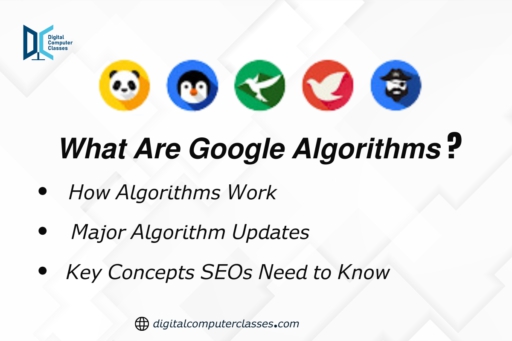Introduction
As part of the expansive online world where websites vie for attention, grasping Google Algorithms is key for those involved in Search Engine Optimization (SEO). These algorithms determine how Google positions websites making them key for those desiring to better their content for improved search visibility.
Whether you’re an experienced SEO expert or a business owner aiming to boost your online footprint, this extensive guide will give you a detailed understanding of Google Algorithms, their development, and what you should know to keep ahead.
What Are Google Algorithms?
Google algorithms are intricate systems created to retrieve data from its search index and furnish the finest possible results for a search. These algorithms consider hundreds of elements, such as keyword relevance, site credibility, and user experience, to position websites on search engine result pages (SERPs).
How Algorithms Work
Essentially, Google algorithms assess several signals, ranging from on-page elements like keywords and meta tags to off-page elements such as backlinks and social signals. The objective is to provide the most pertinent and authoritative results based on the user’s search. Google has ceaselessly fine-tuned its algorithms to enhance the precision and quality of its search outcomes, making it increasingly tricky to control rankings via black-hat SEO methods.
The Evolution of Google Algorithms
Google’s algorithms have developed considerably since the search engine’s start. Here, we outline the history of the major updates that have framed the SEO terrain.
The Early Days (Pre-2000)
Before the introduction of advanced algorithms, Google’s search outcomes majorly relied on keyword density and basic indicators like meta tags. This made it simple for websites to control rankings by stuffing keywords and generating poor-quality content.
Major Algorithm Updates and Their Impact on SEO
Changes to search site rules, like those by Google, really change how one does SEO. These changes usually make search results better by tweaking the way content is judged for value and relevance. These changes can shift keyword standings, how visible a website is, and the total amount of traffic. For instance, changes might highlight user experience, how mobile-friendly it is, or if the content is coming from a trusted source. It’s very important to stay up-to-date with these changes and to adjust SEO techniques as needed. This can help you keep or get better search engine ranks. Knowing about the latest algorithm changes helps companies and web owners fine-tune their content. This helps it line up with changing search site needs and get noticed more on the web.
- 2003: The Florida Update
- Overview: The Florida Update was one of the first significant algorithm changes that targeted keyword stuffing and spammy SEO tactics. It marked the beginning of a more sophisticated approach to search rankings.
- Impact: Many websites that relied heavily on keyword stuffing plummeted rankings. The update emphasized the importance of content quality and relevance over mere keyword manipulation.
- 2005: Jagger Update
- Overview: The Jagger Update focused on reducing the impact of low-quality backlinks and link farms. It introduced penalties for websites engaged in unnatural link-building practices.
- Impact: Websites with poor backlink profiles were penalized, encouraging SEOs to focus on acquiring high-quality, relevant backlinks.
- 2011: Google Panda
- Overview: The Panda update targeted low-quality content, thin content, and content farms. It aimed to elevate the ranking of high-quality sites while demoting those with poor content.
- Impact: Websites with duplicate content, excessive ads, and low-quality articles were hit hard. Panda emphasized the need for original, valuable content.
- 2012: Google Penguin
- Overview: Penguin focused on penalizing websites that engaged in manipulative link-building tactics, such as buying links or participating in link schemes.
- Impact: Websites with unnatural link profiles saw significant drops in rankings. This update underscored the importance of earning organic, natural links.
- 2013: Google Hummingbird
- Overview: Hummingbird was a significant overhaul of Google’s core algorithm, designed to better understand the intent behind search queries. It introduced the concept of semantic search.
- Impact: Hummingbird enabled Google to provide more accurate results for conversational and long-tail queries, paving the way for voice search optimization.
- 2015: Mobilegeddon
- Overview: The Mobilegeddon update prioritized mobile-friendly websites in search rankings. With the growing number of mobile users, Google aimed to ensure a better user experience across all devices.
- Impact: Websites that were not mobile-optimized saw a decline in rankings, making responsive design and mobile usability crucial for SEO success.
- 2015: RankBrain
- Overview: RankBrain is a machine-learning-based component of Google’s algorithm that helps interpret complex queries and improve the relevance of search results.
- Impact: RankBrain added a layer of artificial intelligence to Google’s algorithm, making it better at handling ambiguous and complex queries. SEOs needed to focus more on user intent and content relevance.
- 2018: Medic Update
- Overview: The Medic Update primarily affected health, wellness, and medical websites, though its impact was felt across other niches as well. It emphasized E-A-T (Expertise, Authoritativeness, Trustworthiness) as critical factors in ranking.
- Impact: Websites in the YMYL (Your Money Your Life) category needed to demonstrate higher levels of expertise, authority, and trustworthiness to maintain or improve rankings.
- 2019: BERT
- Overview: BERT (Bidirectional Encoder Representations from Transformers) is a neural network-based technique for natural language processing (NLP). It helps Google better understand the context of words in a search query.
- Impact: BERT improved Google’s ability to understand the nuances and context of search queries, making content that aligns with user intent more important than ever.
- 2021: Page Experience Update
- Overview: This update introduced Core Web Vitals as ranking signals, focusing on the loading speed, interactivity, and visual stability of a webpage.
- Impact: Websites that offer a poor user experience, particularly in terms of page load times and mobile usability, faced potential ranking drops. This update highlighted the need for technical SEO and a focus on user-centric metrics.
- 2022: The Product Review Updates
- Overview: Google introduced several updates targeting product review sites, with an emphasis on high-quality, in-depth reviews.
- Impact: Websites with superficial or low-quality product reviews saw their rankings decline. Detailed, well-researched reviews became essential for maintaining visibility in this niche.
Key Concepts SEOs Need to Know
As Google’s algorithms continue to evolve, SEOs must stay informed about the factors that influence rankings. Below are some key concepts every SEO professional should understand.
On-Page SEO Factors
On-page SEO is about making each web page as good as it can be, hoping to move it up in search results. This means doing things like tweaking title tags, meta descriptions, headers, and content so that they’re relevant to key phrases. The content’s got to be helpful, organized well, and easy for users to understand.
Off-Page SEO Factors
Its job is to tweak how your site shows up in search engine results. Building up backlinks is a big part of this, but so is working with social media, talking about your brand, and marketing with influencers. You’ll want to aim for backlinks from sites with lots of authority.
User Experience (UX)
User experience, or UX for short, is pretty important when it comes to ranking. Upgrades like Mobilegeddon and the Page Experience Update really focus on this. Google likes websites that are user-friendly on all devices. The speed of your site, how well it works on mobile, and how easy it is to get around are all key factors.
Core Web Vitals
Core Web Vitals were added to the Page Experience Update. They’re things Google thinks are important for users to have a positive experience. They include things like Largest Contentful Paint (LCP), First Input Delay (FID), and Cumulative Layout Shift (CLS). Tweaking these can really help how your site ranks.
E-A-T (Expertise, Authoritativeness, Trustworthiness)
E-A-T (Expertise, Authoritativeness, Trustworthiness) came out in Google’s Quality Rater Guidelines. It’s very important for YMYL websites. Showing off your know-how, being a leader, and being reliable through quality content, good backlinks, and user feedback can give your rankings a good bump.
How to Stay Updated with Google Algorithms
Google frequently updates its algorithms, sometimes without public announcements. Staying informed is critical to maintaining and improving your website’s ranking. Here are some strategies:
Monitoring Google Announcements
Now and then, Google shares key updates on its system. They use their official sites, like the Google Search Central Blog. Keeping up with these updates gets you ready for tweaks and helps fine-tune your SEO game plan.
SEO Tools and Analytics
Tools for SEO, such as Google Analytics, SEMrush, Moz, and Ahrefs give you a peek into your website’s performance. They shows how changes in algorithms might influence it. Keeping a close watch on your site’s analytics lets you spot and tackle problems fast.
Industry Blogs and Experts
Checking out business blogs, discussions, and SEO gurus online can offer worthy knowledge and current data on algorithm switches. Groups like Search Engine Land, the Moz Blog, and Webmaster World are top-notch sources.
Conclusion
Google’s algorithm changes have deeply influenced SEO, requiring experts to constantly adjust to keep their rankings. From the past focus on cramming in keywords to today’s stress on user needs and E-A-T, the world of search engine optimization is more intricate.
As Google hones its algorithms, staying educated and flexible is vital. Concentrating on premium content, user comfort, and honest SEO tactics, allows successful navigation through these adjustments. This keeps your site strong in the constantly shifting online world.
The upcoming algorithm changes from Google could see more AI and machine learning developments, making SEO a fluid and demanding field. Nevertheless, armed with the right information and methods, staying forward-thinking and successful is achievable.

